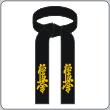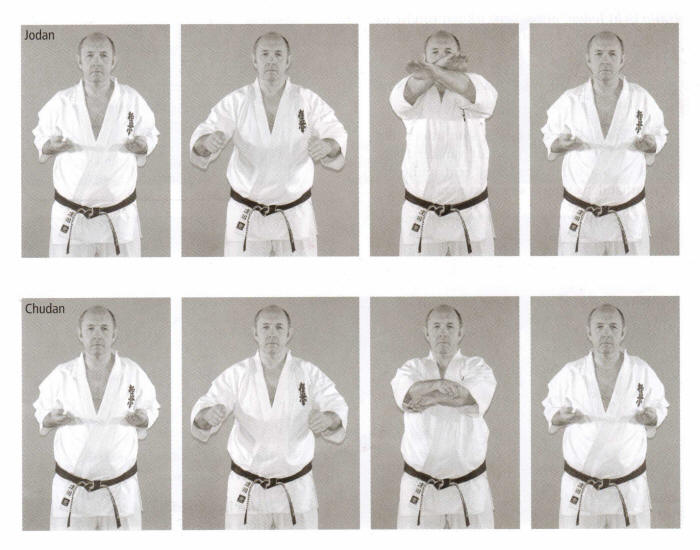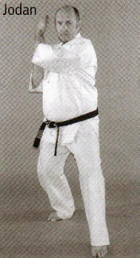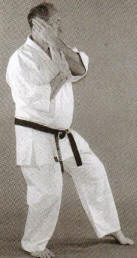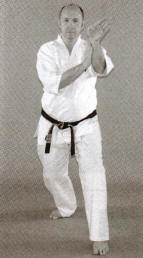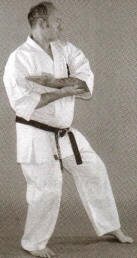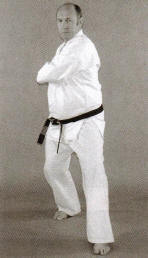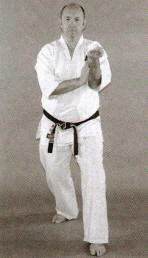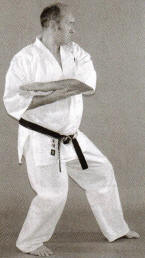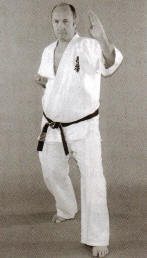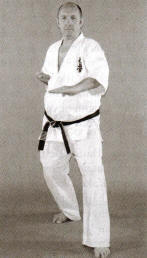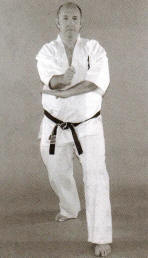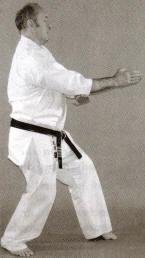FIRST
DAN - BLACK BELT
SHODAN
初段
Here you will find all the
information you need to prepare you for your grading. This information includes
your theory and your practical test. I hope this information helps you in giving
you a better understanding about Kyokushin Karate and also gives you a better
understanding of your requirements and at the same time helps you to study and
prepare for it.

MEANING OF THE BELTS
Below you will find a possible interpretation
of the symbolism of the belt colors. I hope this will give a further
understanding the sense in which the Obi (belts) colors mean. Belts colors are
not only to reflect growth in technique, but also in character.
The Black Belt
(Achievement/New Beginning)
Equipped with a basic
ability and understanding, your journey begin. The step from Brown Belt to Black
Belt is the most important in the life of the Karate-ka. Practices in techniques
should be now for the purpose of fine tuning. Black, like White, occurs rarely
in nature and is often not regarded as a color as such. This is the color of the
spirit. Black is the color of strength. The Black Belts is the strongest of all
Karate-ka, and not colored Belt can cover him. Like the White Belt that
gradually become Black, his Black Belt slowly fades, becomes frayes at the
edges, and turn White again. Thus the circle is inevitable complete; the expert
become the student once more. Seeking the ultimate truth is the only way.
Do It Now
High
achievers accomplish their goals by planning far in advance, but more
importantly through their day-to-day activities. The goal of becoming a black
belt begins in the mind, but is accomplished by daily sweat and training.
Through out the ages, we have watched the winners in combat and adopted their
attitudes and behaviors because we have seen the ramifications of using the
strategy and tactics of their loosing adversaries. A warrior understands that it
is easy to know how to become successful in battle or even life. Simply watch
what successful people do and duplicate their actions.
All
successful people have a unique ability to see the future through a keen vision.
They create their future one step at a time by chipping away those things that
are standing in the way of their success. They know that where they are right
now is based on their actions from the past and likewise, where they will be in
the future is based on what they do right now. The actions they need to take
right now to reach their future goals are usually not highly evolved tactics,
but very basic things linked to universal truths. To understand yourself and the
world around you, you must learn to incorporate these universal truths into your
everyday life. One of these classical principles is to do it now.
In
Japanese martial arts, combat tactics are discussed in reference to the timing
of the movement. For example, Go no Sen is a counter attack which translates as
after, before. In other words, you implemented your technique after your
opponent launched his attack. He attacks and then you counter. The next level of
techniques, is Sen no Sen which translates as before, before. This is where you
initiated your technique at the same time that the attack occurs. To be
successful at this higher level, you must develop a great sense of awareness and
timing, reading the subtlest signs that most people would not even recognize.
The highest level of techniques is Sen no Sen level where one actually counters
a conflict before that action is ever initiated. It is at this level where the
real senior tacticians and most successful people dwell.
To
understand the sophistication of this level of conflict resolution, you must
understand that all the biggest problems you have ever had in your life, began
as a little one. If one learns to deal with situations at the lowest level, they
never become a crisis, and you can spend your energy on more productive goals.
Take for example a simple punching attack. If you wait till it gets to full
speed and at full extension, then it can be very powerful and dangerous. If
however, you reach in and stop the attack just as its being thrown, it is easily
nullified.
This
self-defense principle works in other areas as well. Lets look at time
management for an example. One of the biggest time wasters is to handle an item
several times by putting it off to another time. You receive a letter and place
it in a pile, only to look at it at a later time and file it again. By taking
care of the business as it comes in and only dealing with it once you save a
tremendous amount of time and increases your productivity.
On a
personal and even professional level, we may have a tendency to avoid an
uncomfortable situation by not discussing a problem we have with another person
or an employee. By not handling the problem at the lowest level, many times this
situation will grow into a serious problem later on. Whenever you identify a
problem of any nature it is better to try and resolve it right away.
The
very best way to deal with a problem is to create proactive action plans that
prevent them from occurring in the first place. The very best preventative
action is to stay busy working on your short-term goals by identifying what is
the most important thing you could be doing right now that will allow you to
reach these goals in the shortest and most efficient manner. Once this has been
identified, the key is to remember “do it now”.
"Studying the Martial
Way is like climbing a cliff; keep going forward without rest. Resting is not
permissible because it causes recessions to old stages of achievement.
Persevering day in, day out improves techniques, but resting, even one day,
causes lapses. This must be prevented."
Sosai Masutatsu Oyama
You must find
out what it mean the Black Belt to you. It is a recognition of skill by your Sensei or is
it a recognition of something more and deeper commitment to a way and philosophy
of life? For some students it meant a sense of responsibility to make sure
your Kyokushin is kept to a good standard, and to work on improvement, as well
as set a good example to other students.
However, the more important is what it means to you.

WHAT YOU SHOULD KNOW FOR YOUR
KYOKUSHIN THEORY TEST
FIRST DAN - BLACK BELT/SHODAN
NOTE: PLEASE KEEP IN MIND THAT THIS LEVEL
(SHODAN) IS NOT FINISHED YET, SO YOU MUST CHECK THIS OFTEN AS I MAY BE DOING
SOME CHANGES TO THIS REQUIREMENTS. THANK YOU!
Below are some vocabulary you should be able to know in order to do
your grading.
|
vocabulary |
|
Name |
Meaning |
|
Shodan |
The
first step up a cliff |
| Sho |
Beginning (Sho can means "First" but only because it means beginning)
|
| Dan |
Rank,
Level
|
| Dan |
The
Kanji for Dan (段)
literally means "Carve steps up the cliff" |
|
Yudansha |
Black
Belt Holder |
| Ken |
Knuckles |
|
Yubi |
Fingers |
|
Oyayubi |
Thumb |
|
Koyubi |
Little
Finger |
|
Hitsashiyubi |
Forefinger |
|
Kusuriyubi |
Fourth
Finger |
|
Ryuto-Ken |
Dragon's Head Fist |
|
Ryuto-Ken Tsuki |
Dragon's Head Fist Trust |
|
Nakayubi |
Middle Finger |
|
Ippon-Ken |
Knuckle Fist |
|
Nakayubi Ippon-Ken |
Middle Finger Knuckle Fist |
|
Oyayubi-Ippon-Ken |
Thumb
Knuckle Fist |
| Toho |
Sword
Peak Hand |
| Toho
Uchi |
Sword
Peak Hand Strike |
| Keiko
|
Chicken Beak Hand / Training |
| Keiko
Uchi |
Chicken Beak Hand Strike |
| Kake |
Hook |
| Kake
Uke |
Hook
Block |
| Osae Uke |
Push
down Block |
| Hiza |
Knee |
| Hiza
Uke |
Knee
Block |
| Yama
Tsuki |
Double
Strike (Vertical) |
|
Haito |
Inner knife hand |
| Ago |
Chin |
| Atama |
Head |
| Ganmen |
Face |
| Hana |
Nose |
| Kao |
Face |
|
Komekami |
Temple |
| Kubi |
Neck |
| Kuchi |
Mouth |
| Me |
Eye(s) |
| Mimi |
Ear(s) |
| Nodo |
Throat |
| Buchi |
Warrior |
|
Buchido |
Way of
the Warrior |
YOU SHOULD BE ABLE TO EXPLAIN IN MORE DETAILS:
![]() which
means "lion law" (pronounced "saifa"
in the Hokkien/Amoy dialect or "shifa"
in Mandarin). Kinjo supports this idea by noting that saifa
contains a double punch that is traditionally performed in many
schools as a "hira ken" (foreknuckle fist punch) in the manner
used in the lion school.
which
means "lion law" (pronounced "saifa"
in the Hokkien/Amoy dialect or "shifa"
in Mandarin). Kinjo supports this idea by noting that saifa
contains a double punch that is traditionally performed in many
schools as a "hira ken" (foreknuckle fist punch) in the manner
used in the lion school. 